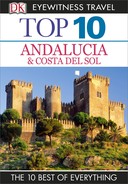Parque Nacional del Coto Donana
The largest nature reserve in Europe and southern Spain’s only national park was established in 1969. It covers more than 247,000 acres (99 ha), including its surrounding buffer zones, and its wide variety of ecosystems, rare fauna and abundance of bird life make it so vital to the environmental stability of Western Europe that it enjoys the status of a UNESCO Biosphere Reserve. To the untrained eye, it yields up its natural wonders gradually, but a visit to the coastal area of western Andalucía is not complete without a visit.
![]() Reservations for 4x4 guided tours 959 43 96 29 • Open 8am–7pm daily (summer: to 9pm); Tours 8am & 5pm (summer), 8am & 3:30pm (winter) • Tours €28.00
Reservations for 4x4 guided tours 959 43 96 29 • Open 8am–7pm daily (summer: to 9pm); Tours 8am & 5pm (summer), 8am & 3:30pm (winter) • Tours €28.00
![]() Centro de Información La Rocina • 959 43 95 69 • Open 9am–7pm daily (summer: 10am–3pm & 4–8pm)
Centro de Información La Rocina • 959 43 95 69 • Open 9am–7pm daily (summer: 10am–3pm & 4–8pm)
1. Setting and History
Located at the estuary of the Guadalquivir River, the area probably owes its present pristine condition to the fact that it was set aside as a hunting preserve for the nobility in the 16th century.
2. Habitats
The park comprises three distinct types of ecosystem: dunes, coto (pine and cork forests and scrubland) and marisma (wetlands). The wetlands can be broken down into marshes, salt marshes, lagoons and seasonally flooded areas.
3. Flora
Umbrella pines and cork-oaks flourish here and both types of tree provide crucial nesting sites for many birds. Wildflowers in the dunes and scrubland areas include the bright pink spiny-leafed thrift, besom heath, yellow gorse and the bubil lily. Marshland vegetation is made up of bullrushes, other types of reeds and white-flowered buttercups.
4. Fauna
The endangered pardel lynx is the emblem of the park. As many as 25 pairs of the very rare Iberian eagle also survive here. Other birds include the rare purple gallinule and the flamingo, but at least 300,000 birds make their home in the park.
5. Visitor Centres
Several Visitor Centres offer exhibitions as well as planned trails, which lead to birdwatching opportunities and rest areas.
6. Guided Tours
Tours in all-terrain vehicles depart from the Visitor Centres. Two visits per day have varying itineraries, depending on the time of year. The marshes dry up in the summer months, which limits birdwatching, but increases the chance of seeing rare mammals.
7. Bird Shelter
The Centro de Visitantes El Acebuche, the main visitor centre, is set on a lagoon. At the eastern end there is an aviary where rescued and recuperating birds get intensive care. It’s an opportunity for visitors to view them – including some unusual species – fairly close-up.![]() Centro de Visitantes El Acebuche • Ctra A483, 3 km (2 miles) from Matalascañas • 959 43 96 29
Centro de Visitantes El Acebuche • Ctra A483, 3 km (2 miles) from Matalascañas • 959 43 96 29
8. Huts
Dating from the 18th century, these traditional huts are found in the pinares (pine forests). Sometimes clustered into small villages, the uninhabited structures are pinewood frames covered with local thatch.
9. El Palacio de Acebron
This Neo-Classical style hunting lodge, built in 1961, has a permanent exhibition on the history and ethnography of the region. There are good views from the upper floors and the site is a starting point for a 12-km (8-mile) trail through the nearby woodlands.
10. El Rocio’s Romeria
This town (for further details see El Rocío) is the focal point of one of Spain’s largest festivals, the Romería del Rocío. The four-day pilgrimage leading up to Whitsun has dispensation to wind its way through the park. Thousands of people come to honour Nuestra Señora del Rocío, a medieval statue said to
have miraculous powers.![]() El Rocío Turismo • Avda de la Canaliega • 959 44 38 08
El Rocío Turismo • Avda de la Canaliega • 959 44 38 08
Ecological Issues
Despite vigilant efforts to protect the park, in 1998 a Río Tinto mining toxic waste storage burst, dumping pollutants into the Guadiamar River, one of the wetlands’ main tributaries. Thankfully, the poisonous wave of acids and heavy metals was stopped just short of the park, but damage was done to its border areas. As a result of this disaster, strict measures are enforced to prevent further pollution.
